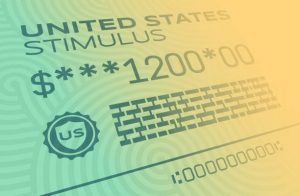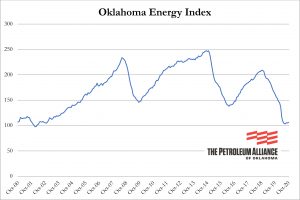
United States Treasury stimulus payment for Coronavirus CoViD-19 outbreak disease.
Some in the oil and gas industry in Oklahoma say the federal stimulus money received by the state and its residents has led to a false perception that the economy and industry might be stronger than reported.
Petroleum Alliance of Oklahoma President Brook A. Simmons said the recovery of the state’s oil and natural gas industry is expected to be a long and arduous one. In a recent announcement, the Alliance said Oklahoma’s oil and natural gas industry continues its long, slow march to better days, but the influx of federal dollars into the state in the wake of the COVID-19 pandemic clouds the economic impact of depressed oil and natural gas prices for the industry and the state as a whole.
Increases in natural gas prices as colder weather sets in and home heating demands rise coupled with addition of more drilling rigs to the Oklahoma landscape helped push the Oklahoma Energy Index higher using the most recent data available. The Energy Index now stands at 106.4, an increase of 1.4% from the previous month but still 34% less than one year ago.

The OEI is a comprehensive measure of the state’s oil and natural gas economy established to track industry growth rates and cycles in one of the country’s most active energy-producing states. The OEI is a joint project of The Petroleum Alliance of Oklahoma and the Steven C. Agee Economic Research and Policy Institute.
But the true economic impact of the downturn in the state’s defining industry is still to be seen, said Dr. Russell Evans, executive director of the Steven C. Agee Economic Research and Policy Institute. Historically, a significant contraction in the oil and natural gas sector has led to a statewide recession with a falling gross state product, personal income and employment.
The reality of a struggling industry the state has relied on as its economic driver has yet to be seen, Evans said, because of a large influx of federal dollars used to mitigate the economic impact of the COVID-19 global pandemic. The tremendous inflow of federal money in the form of stimulus payments, unemployment insurance supplements and Paycheck Protection Program loans led to a 47% increase in personal income in Oklahoma during the second quarter of 2020 even though the state’s GDP fell by 31% during the same timeframe.
Evans noted the federal influx has overshadowed the fact that wages and salaries in the oil and natural gas industry are down 35% from January 2019 and down 47% from their recent peak in 2015. When the flow of federal dollars comes to an end, he said, the full economic impact of an industry downturn that began in 2018 will be felt.
“In a state with a history of boom-and-bust cycles, the current cycle borders on unprecedented,” Evans said. “The economic effects are real and all around us, even if we are too numbed by federal policy to feel the pain.”
Petroleum Alliance President Simmons said the recovery of the state’s oil and natural gas industry is expected to be a long and arduous one with a myriad of issues stymieing quick growth in the state’s bedrock industry, including mergers, acquisitions and bankruptcies that have reduced the number of companies working in the Sooner State’s oilfields, depressed commodity prices and the 2018 increase in the state’s gross production tax that removed Oklahoma’s competitive policy advantage over other energy-producing states.
“Commodity prices and geology will always be the prevailing forces pushing companies to expand or contract their drilling budgets,” Simmons said. “But state and local policies can tip the scales to determine where drilling rigs — and the economic activity that surrounds them — are most active. Today, the scales are not tipped in Oklahoma’s favor.”
Source: Petroleum Alliance of Oklahoma






